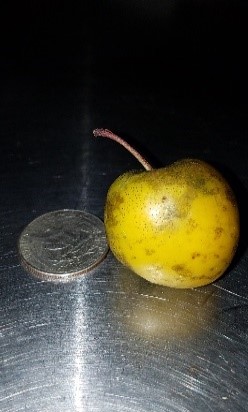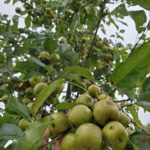$19.95 – $35.95
A grafted fast-growing tree with good disease resistance produces abundant annual crops of 1 ¾” crabapples that are good for eating out of hand and the deer. It is a highly vigorous tree and produces fruit annually. I have seen excellent resistance to cedar apple rust, fireblight, and powdery mildew in a no-spray situation. I have seen apple scab develop on leaves and fruit in a no-spray situation in years of excessive rain. Prime Time Crab will begin dropping in the last weeks of October and continue through November and December. This crabapple also is dropping a lot of fruit into December here in Pennsylvania and is one I wouldn’t have a fruit orchard without this tree in it. It doesn’t take but to look at my pictures of this tree, and you can see why I would not have an orchard with a few prime time crabs growing in it. For a video of a young Prime Time Crab, CLICK HERE. The tree is highly productive and provides a maximum draw at just a perfect time. This tree will reach a mature height of 20’+. Plant Hardiness zones 5-8
Only available in 2-yr trees.
Description
PRIME TIME CRABAPPLE
The Prime Time crabapple is a tree with a good disease resistance that produces abundant annual crops of 1 ¾” crabapples that are good for eating out of hand and for the deer. I have seen excellent resistance to cedar apple rust, fireblight, and powdery mildew in a no-spray situation. I have seen apple scab develop on leaves and fruit in a no-spray situation in years of excessive rain. It is a very vigorous tree and produces fruit annually. This tree originated in Central Indiana from whitetail enthusiast Mr. John Trout and is also known by the name Lemon Drop due to having a touch of citrus flavor followed by a lot of sweetness. Prime Time Crab will begin dropping in the last weeks of October and continue through November and December. This tree provides a maximum draw at just the right time….Prime Time!! Hardiness zones 5-8.
The Prime Time crabapple is made by using plant tissue from the original tree and attaching it to the new roots. This process essentially gives you an identical tree to the one you see in the picture and description.
TREE SIZE
2-3′ ( 3/8″ dia.) These trees will have a good root system. They will be whips around 3′ high with a trunk diameter of 3/8″.
3-5′ ( 1/2” dia.) These trees will have a good root system with some possible branching but will mainly be whips. They will range in height between 3′ to 5′ with a trunk diameter of around 1/2″.
4-6′ (+ 1/2” dia.) These trees will have an extensive root system and typically have multiple branches, but many will be solid whips. They will range in height between 4′ and 6′ with a 1/2″ to 3/4″ trunk diameter.
2-yr 4-6′ (5/8”-3/4” dia.) These two-year-old trees will have an extensive root system and can have multiple branches with a diameter of 5/8” and greater. We will be pruning the trees back to a shipping height of 66” with the roots. Our largest box is 66″x 14″x 15″ and will hold 15 of the 2-yr trees. Free local pick-up is open to the surrounding states of Pennsylvania.
STANDARD ROOTSTOCK
Prime Time Crabapple is grafted to a standard root that is extremely cold, hardy, and vigorous. This Rootstock is an excellent choice for wildlife trees because it produces a full-size 20’ to 30’ tree. Producing a full-size tree for wildlife means much more fruit on a given tree. This rootstock will develop deep ”Real roots” making it exceptionally well anchored, penetrating well into the subsoil, pulling up lost nutrients, and making it very drought tolerant. This root is a great all-around rootstock for wildlife plantings.
This standard-size rootstock is adaptable to many soil types and conditions, especially when planted in less desirable locations. Therefore, with its full vigor, can be used in areas that were once wooded and are now food plots, reclaimed land, shale mountain soil, dryer uplands, and ridges. This standard rootstock will also perform well in improved soil in an orchard-style setting. We are only grafting onto the most vigorous roots in a given year. When grafting onto the top 30% of seedlings, you get a rootstock about 40% more vigorous tree than many clonal stocks used for wildlife trees today. Prime Time Crabapple is very precocious, with many trees producing very quickly anon this standard root making it an all-around excellent rootstock for wildlife plantings.
PLANTING INSTRUCTIONS FOR PRIME TIME CRABAPPLE
Plant at least one different apple or crabapple variety within proximity to the Prime Time Crabapple tree for pollination. Grams Gift crabapple, Enterprise apple, or Chestnut crabapple will make Prime Time crab excellent pollinators. Plant your Prime Time tree in moist, well-drained soil with a soil pH between 5.8 – 7 with adequate nutrient levels for optimal growth.
If you have not completed a soil test, click here and improve your soil. I would highly recommend doing so. However, if you are not going to, I would recommend mixing 1 ounce for every three sq ft of 0-20-20 granular fertilizer in your soil at the time of planting. The first number tells you a percentage of nitrogen contained in the fertilizer. Nitrogen applied directly to the tree’s roots will cause death to your tree. Make sure the first number is zero. Aged compost is also appropriate when applied in the correct amounts.
Nitrogen is very mobile in the soil, and you can apply a small of nitrogen the following year. The 2nd and 3rd numbers are Phosphorus and Potassium. Apply these two nutrients at or well before planting because they are immobile in the soil. They will need to be mixed in through the soil. We recommend completing a soil test and making amendments for best results. We recommend applying 1 lb of 10-10-10 for every inch of diameter in the spring the following year and each year after planting.
Prime Time Crab requires a minimum of 6 hours of sunlight for growth and fruit production. Space trees 20′ apart and use at least 5′ cages to protect your trees. This will ensure your deer eat your fruit in a few years and not your trees this year.
SHIPPING/PICK UP
Shipping to Plant Hardiness zones 2 – 8 will begin again in mid-March on Mondays, Tuesdays, and Wednesdays (you select your ship date) and continue until the last Monday in April. Dormant bare-root trees must be planted in the spring, while trees in your area remain dormant. You can select your ship date as you checkout on the website. If you are picking up your trees, typically, the last week in March or the first week in April is perfect for planting in Pennsylvania. We have opened up the free local pick-up to the surrounding states as it could be more cost-effective if you order more than 30 trees. You can select your pick-up date on the website as you checkout. Please call or message us to make an appointment to pick up your trees if you can not make the date you selected.
For More Information Visit:
Additional information
| Weight | 18 oz |
|---|---|
| Dimensions | 58 × 2.30 × 2.30 in |
| Tree Size | 2-3' (3/8'' dia.), 3-5' (1/2'' dia.), 4-6' (+1/2'' dia.), 2-yr old 4-6' (+5/8''dia.) |
Only logged in customers who have purchased this product may leave a review.





























 by
by
Reviews
There are no reviews yet.